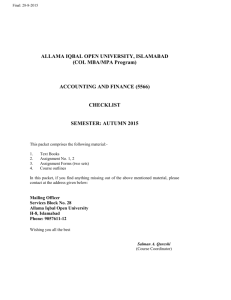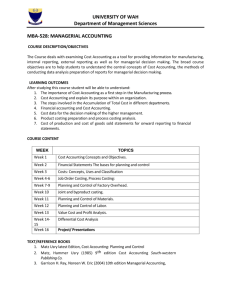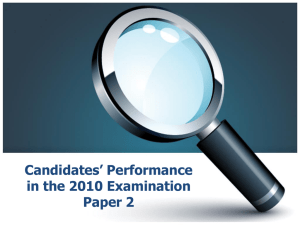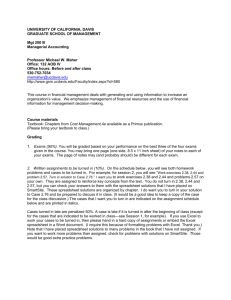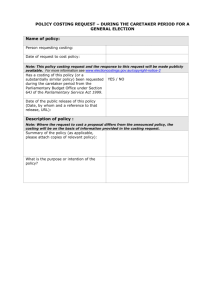Cost Management Practices in India: An Empirical Study
advertisement
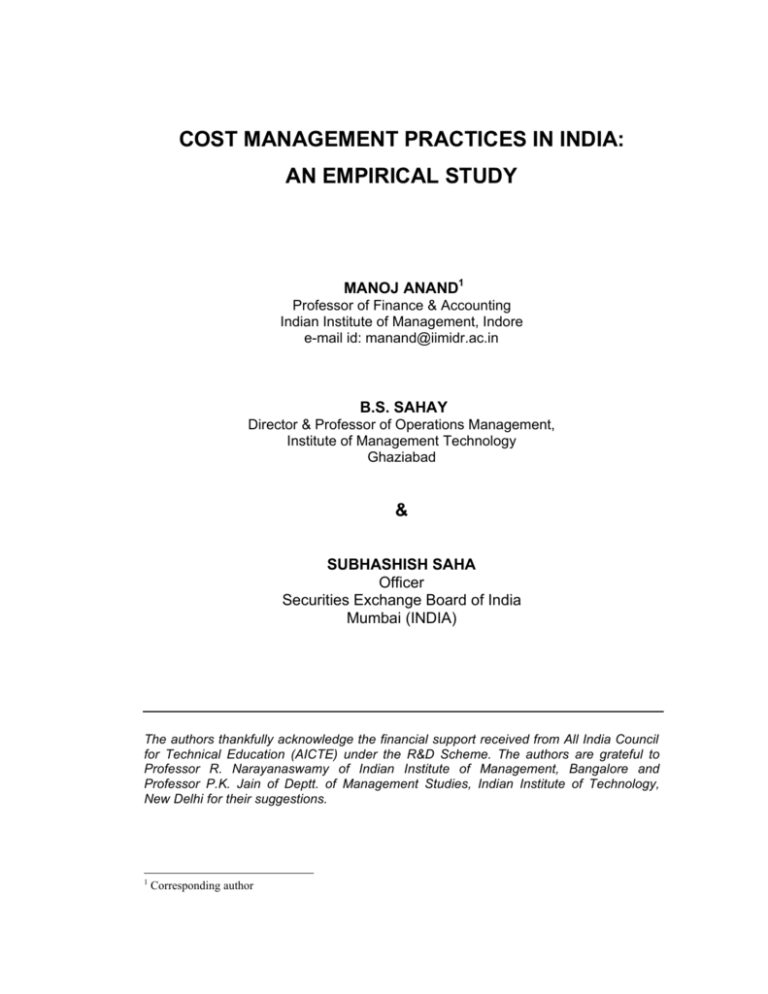
COST MANAGEMENT PRACTICES IN INDIA: AN EMPIRICAL STUDY MANOJ ANAND1 Professor of Finance & Accounting Indian Institute of Management, Indore e-mail id: manand@iimidr.ac.in B.S. SAHAY Director & Professor of Operations Management, Institute of Management Technology Ghaziabad & SUBHASHISH SAHA Officer Securities Exchange Board of India Mumbai (INDIA) The authors thankfully acknowledge the financial support received from All India Council for Technical Education (AICTE) under the R&D Scheme. The authors are grateful to Professor R. Narayanaswamy of Indian Institute of Management, Bangalore and Professor P.K. Jain of Deptt. of Management Studies, Indian Institute of Technology, New Delhi for their suggestions. 1 Corresponding author COST MANAGEMENT PRACTICES IN INDIA: AN EMPIRICAL STUDY Abstract The present study of 53 CFOs of corporate India captures the development in the cost management practices such as accounting for overheads, applications of budgetary control and standard costing. It addition to traditional cost management techniques it also deals with applications of contemporary management tools such as activity-based costing. The hypotheses in general deal with the difference in the practices across sectors, stages, and level of adoption of contemporary cost management techniques. The firms are successful in capturing accurate cost and profit information from their ABC cost systems for value chain and supply chain analysis. The results suggest that the firms have better insight for benchmarking and budgeting with ABC cost system yet the consistency in their priority of budget goals is lacking unlike the firms who are using traditional costing systems. However both the ABC and traditional cost system users have clarity of reasons for effective implementations of planning and budgeting process in their organizations There is no significant difference in the application of standard costing between the ABC-users and the traditional costing system users. This implies that the use of activity-based cost systems and standard costing is not mutually exclusive. There is a widespread use of sales variances and material variances vis-à-vis labor and overheads cost variances. 2 COST MANAGEMENT PRACTICES IN INDIA: AN EMPIRICAL STUDY Introduction In today’s time of rapid technological change, tough global and domestic competition, total cost management is central to sustained corporate profitability and competitiveness. The management mantra today is conquer your costs, before they conquer you. The cost means total cost to the customer. The cost leadership strategy does not mean compromise on either quality or technology or product differentiation. Low costs are no advantage, if the customers are not willing to buy the product of low cost firm. Cost management has to be driven with customer as the focus. The survival triplet today for any company is how to manage its product/service cost, quality, and performance. The customers are continuously demanding high quality and better performance products/services and at the same time, they want the prices to fall. The shareholders are also demanding a required rate of return on their investment with the company. Thus, cost has become a residual. The challenge is being able to manufacture or provide service within the stipulated cost framework. Thus, cost management has to be an ongoing continuous improvement programme. Today the market leaders are even pursuing cost-reduction as a strategic imperative. They want to stay ahead of the market by continuously widening the gap between their cost and that of their competitors and re-deploy the resources for profitable growth. Thus, the cost challenge is one of the most critical tasks facing Indian Industry during the next decade in the post-WTO environment. The framework will be of activitybased cost and performance management in a value chain perspective. Objectives of the study The present study intends to capture the development in the cost management practices such as accounting for overheads, applications of budgetary control and standard costing in the corporate India. The study plans to tests the hypothesis that the firms using activity-based costing system are: a) more likely to have a: i) better insight for benchmarking and budgeting; ii) clear structure of priorities of budget goal; iii) clarity of reasons for effective implementation of planning; and budgeting process in their organization; and 3 b) less likely to use i) department-wide budgeting systems, ii) absorption costing systems, and iii) variable costing systems vis-à-vis the firms that follow traditional costing system. It further plans to verify whether there is a significant difference in the management motivation for the implementation and the use of standard costing as a management control tool between ABCM-user firms and firms using traditional costing systems. Research Methodology A nationwide survey was conducted to capture the issues in the design and applications of contemporary cost management tools. The questionnaire was sent to the CFOs of the 579 companies consisting of the bt-500 private sector companies, 75 most valuable PSUs, and four subsidiaries of multinational corporations in batches during October 30, 2002 to November 7, 2002. Subsequently, two reminders were issued (one in December 2002 and the second in February 2003) for follow-up in order to maximize the response rate. It was indicated to the CFOs that the identity of the respondent companies as well as the persons responding on their behalf will be kept strictly confidential and only aggregate generalizations would be published. Fifty-three completed questionnaires had been received by June 9, 2003. All the four MNCs responded. In addition, 49 out of the remaining 575 with a response rate 8.52%2 returned the duly filled questionnaires. These 53 companies constitute the sample for deriving inferences of the present study (Table 1). In any such survey it is likely that the firms that did not respond on time may have non-response bias. Whatever the respondents have said is believed to be their true response. Another limitation of the survey methodology is that it measures believes and not necessarily actions. All in all, the versatility in the characteristics of respondent firms enabled the present study to examine the cost management practice vis-à-vis theory. 2 This response rate is low as compared to Joshi (2001)’s 24.4% in a survey mailed to 246 CMIE list of 500 Indian companies but much higher as compared to Rigby (2001)’s only 1.8% in a survey mailed to North American executives. 4 Table 1: Industry Composition of Sample Industry Consumer Durable, Personal Care & Food Products Engineering & Capital Goods Chemicals & Pharmaceuticals Power Generation & Transmission Tractors Automobiles & Auto Ancillary Construction, Cement & Building Material Information Technology - Software Oil & Gas and Petrochemicals Telecom & Electronics Equipment Tyres Diversified Iron Ore & Non-Ferrous Metals Textiles Others (Logistics, Banking, Telecom services Consultancy airline services trade services etc) Total Sample Size 7 6 4 4 4 4 3 3 3 2 2 1 1 1 8 Sample proportion 13.21 11.32 7.55 7.55 7.55 7.54 5.66 5.66 5.66 3.77 3.77 1.89 1.89 1.89 15.09 53 Twenty-six respondents firms out of 53 are using activity-based costing for product pricing and operational feedback. Nearly 77% of the ABCM users firms are in the manufacturing sector and 23% in the service sector (Fig. 1). This ABC adoption rate compared favorably with nearly 38% in India in 1999, 26% in the USA, 20% in UK and 40% in Norway (see for example, Business Today, 1999; Innes and Mitchell, 1995; Innes, et. al. 2000; Ittner et.al.2001; and Bjemenak, 1997). Nearly 58% of the ABCM users firms have fully integrated cost management and financial reporting systems with enterprise resource planning system. 57.69% of the respondents extended their ABC systems to advanced stage extending it upto facility level and customer level activities. Seventy-six percent users of the activity-based costing in Canadian firms have implemented the activity-based cost system as supplementary and offline (Armitage and Nicholson, 1993). The 42.3% of the ABC-user firms are using activity-based costing in their company for more than two years. 5 Service 23% Manufacturing 77% Fig. 1: Sector profile of ABC users Research Study Findings Success with the present cost management systems Table 2 shows the success of the existing cost management systems in terms of capturing the accurate cost information for product pricing, inventory valuation, value chain analysis, supply chain analysis and outsourcing decisions. 52.8% of the respondents have achieved success in application of their present costing system in product pricing and inventory valuation. The success ratio in the area of value chain analysis & supply chain analysis and out-sourcing decisions is 22.7% and 28.3% respectively. 54.8% of the firms were successful in accurate profit analysis by product, 24.6% by process and 30.2% by department and customer. The examination of responses conditional on ABC-adoption revealed that the firms who have adopted ABC were significantly more successful in capturing accurate cost information for value chain analysis and supply chain analysis vis-à-vis the firms who had not adopted ABC. 6 Table 2: Sl. No. i. Success Achieved in the Application of Present Costing System to Capture Accurate Cost Information Areas Mean Score Very Successful / Completely Successful Aggregate Non-ABCM User ABCM User Accurate cost information for a) Product pricing 52.8% 3.283 3.00 3.5769 b) Inventory valuation 52.8% 3.0377 2.8148 3.2692 c) Value chain analysis* 22.7% 1.9057 1.2963 2.5385*** d) Supply chain analysis 22.7% 1.8302 1.4444 2.2308* e) Outsourcing decisions 28.3% 2.1132 1.8148 2.4231 ii. Accurate profit analysis a) By product 54.8% 3.1321 2.9630 3.3077 b) By process 24.6% 2.0189 1.8519 2.1923 c) By department 30.2% 2.1132 1.6296 2.6154* d) By customer 30.2% 2.0566 1.8148 2.3077 iii. Better insight for benchmarking and budgeting 43.4% 3.0566 2.4074 3.7308*** iv. Better insight about manufacturing performance 34% 2.6604 2.3333 3.0000 *, **, *** indicate significant at 10%, 5%, and 1% level respectively. Budgetary control The use of the master budget as a part of the management control systems is wide spread. 88.7% of the respondents to the present study prepared the master budget (Fig. 2). Nearly all the companies in Australia, Holland, Japan, UK, and USA prepare master budget (see for example, Asada et al. 1989; Blayney and Yokoyama, 1991; Chenhall and Langfield-Smith, 1998). The respondent firms used more than one budget goal in formulating the master budget. Although 39.6 % of the respondents expressed that maximizing earnings before interest and Tax (EBIT) was their most important budget goal, maximization of economic profit emerged as the most important objective function on aggregate basis, when considered the top three goals. The other objective functions such as minimizing production cost, maximization of operating profits and sales revenue are equally important (Fig. 3). Interestingly, returns on investment and sales revenue were the most important budget goals in the USA and Japan respectively (see for example, Asada et al. 1989; Blayney and Yokoyama, 1991; Chenhall and Langfield-Smith, 1998;). 7 No 11% yes 89% Fig. 2: Master Budget 40 39.6 35 Percentage 30 28.3 24.5 25 22.6 17 20 13.2 20.8 15 18.9 10 5 7.5 5.7 0 Rank 2 To maximize return on investment To maximize To maximize operating Income (EBIT) sales revenue Rank1 To minimize production cost To maximize economic value added (EVA)* Fig. 3: Budget Goals There was significant correlation amongst the budget goal rankings in 7 out of 10 cases in traditional as against 3 in case of ABC-users. Thus, the users of traditional costing system vis-à-vis ABC users had consistency in their priorities of budget goal. 73.6% of the respondents attributed effectiveness of budgeting to well defined strategy, 64.1% to clear linkages of strategy to operational plans and meaningful performance measures and 51% to management control and coordination (Fig. 4). No significant difference had been found in the reasons for effectiveness of planning and budgeting process in their organization between the ABCM users and the non-ABC users. 8 Management control and coordination 51 Meaningful performance measures 64.1 Clear linkage of strategy to operational plans 64.1 73.6 Well defined strategy 0 10 20 30 40 50 60 70 80 Perecentage Fig. 4: Effectiveness of budgeting 50 45.3 45 37.7 40 30.2 Percentage 35 30 25 20 15 11.3 10 Activity-wise 5 0 Department-wise Incremental budgeting Zero-based budgeting Fig. 5: Budgeting Approach 45.3% of the respondents were using department-wise incremental budgeting while 30.2% used activity-wise zero-based budgeting (Fig. 5). The firms using traditional costing system had clarity in the thought process of application of ZBB vis-à-vis ABC user firms. Joint cost allocation The physical measures based joint cost allocation methods were equally popular in India as market-based estimated Net Realizable Value (NRV) method, as against the survey findings of Koester and Barnett (1996). 9 Cost method for product pricing In contrast to the worldwide (Ireland, Japan, and the UK) trend where market based factors were starting point for product pricing decision, in India the present study had found that the cost based factors are equally important (Fig. 6) (see for example, Blaynay and Yokoyama, 1991; Cornick et al. 1988; Mills and Sweeting, 1988). Yes 32% Equally important 62% No 6% Fig. 6: Relative importance of market based to cost based factors for product pricing The full cost-absorption costing (39.6% used it) was found to be more widely used vis-à-vis variable costing (30.2% used it), as evident from Fig. 7 in accordance with the international practice (see for example, Blaynay and Yokoyama, 1991; Cornick et al. 1988; Mills and Sweeting, 1988). There was no significant difference between the ABC users and the traditional costing system users in respect of use of full absorption costing and variable costing for product pricing decisions. Current usage of management tools The most widely used management tool is cost-volume-profit analysis (77.3% use it vis-à-vis 65% adoption rate finding of Joshi, 2001) followed by MRP (41.5%), activitybased budgeting (30.2% vis-à-vis 7% adoption rate finding of Joshi, 2001) and value engineering (30.2%). Other contemporary management tools such as target costing, lifecycle budgeting, Kaizen costing, Quality costing, Taguchi costing did not find many acceptances by the respondent firms (Fig. 8) These findings are in agreement with the findings of Joshi (2001). 10 Unit level activity-based costing of the product 9.4 30.2 Variable cost of the product 13.2 Activity-based Costing 39.6 Absorption costing 0 5 10 15 20 25 30 35 40 45 Percentage Fig. 7: Cost method followed for product pricing decision 90.00% 80.00% 77.30% Percentage use 70.00% 60.00% 50.00% 41.50% 40.00% 30.20% 30.00% 28.30% 30.20% 28.80% 18.90% 20.00% 13.20% 15.10% 11.30% 13.20% 9.50% 5.70% 10.00% C os t-v M at ol er um ia elR pr eq of ui it re an m al en ys tP is la nn i ng Ac Bu (M tiv si ity ne R P) -b ss * as Pr ed oc bu es dg s R et ee in g* ng in ee rin g (B PR Va )* lu e en gi ne er in Ju g* st in Ti m e (J IT )* T St a r ra ge te tc gi os c po tin si g* tio ni ng an al ys Ka is * ize n bu dg et in g* Ka iz en co st Li in fe g* cy cl e bu dg et in g* Q ua lity co st in g* Ta gu ch iC os tin g* 0.00% Fig 8: Usage of cost management tools in India Transfer pricing practices The Indian corporate sector had followed market price based transfer pricing system as against the worldwide practice of cost-based method domestic transfer pricing and market price based method for international transfer pricing (see for example, Tang, 11 1992 and 2001; Joye and Blayney, 1991; Govindrajan and Ramamurthy, 1983; Mostafa et al.1984; and Price Waterhouse, 1984). The motivations for adoption of market based domestic transfer pricing method by the respondent firms were optimal decision making for the organization, divisional autonomy, and motivation for performance. Manufacturing overheads accounting The use of direct method of allocation of service departments' overheads cost amongst the production departments is widespread (Blayney and Yaokoyama, 1991). In India, too the direct method was found to be widely used (62.1%) to allocate support department overheads cost amongst the production department in the first stage of cost allocation (Fig. 9). Surprisingly the reciprocal method, the theoretically more sound method of cost allocation, did not find much acceptance with corporate India and was not at all popular worldwide. The department-wide machine hour rate had been found to be more popular with corporate India vis-a-vis department wide comprehensive machine hour rate (37.9% verses 20.7% used it) for absorbing the production departments' overheads to the final products or services in the second stage of cost allocation (Fig. 10). The practice of corporate India with respect to treatment of under/over-absorbed overheads was in agreement with the generally accepted cost accounting principles. The only exception was that 24.1% of the respondents had written off substantial amount of over or under absorption of manufacturing overheads to costing profit and loss account. Reciprocal method* 27.6 Step-down method* 31 62.1 Direct method 0 10 20 30 40 Percentage Fig. 9: Method of cost allocation 12 50 60 70 40 37.9 35 27.6 Percentage 30 25 20.7 20 10.3 10.3 15 10 10.3 5 Company wide 0 Department wide Machine hour rate Comprehensive machine hour rate Labour hour rate Fig. 10: Method of Overhead absorption Standard costing The standard costing technique as a part of the management control systems had been widely used amongst corporate India. 77.36% of the respondents under study have used it vis-à-vis 53% in the Business Today (1999) survey of 113 large-sized companies. The Indian practice is in agreement with that of the U.S.A. (Waldron and Everett, 2002). No significant difference in the use of standard costing amongst ABC users and nonABC users was found. The use of standard costing is popular worldwide. More than 75% of the firms use it in USA, UK, Ireland, and Sweden (see for example, Cornick et al., 1998; Clarke and Brislane, 2000; and Ask and Ax, 1997). Scarbrough et al. (1991) have found 65% usage of standard costing in Japan. The sales volume variance and selling price variance had been given the highest level of importance over the other variances. This had been followed in material price and material usage variance (70.7% and 70.8% respectively). On an aggregate basis material variances had been given more predominance over overhead variances but when the sample was discriminated in to ABC user/nonuser, it had been found that ABC users were more concerned about overhead variances than the non-users. Drury, et al (1993) finds that nearly two-third companies in the UK view labour efficiency variance of vital importance in control decisions. 13 Table 3: Applications of standard costing in management control decisions Important/ Most Variances Sl. No. important Aggregate (%) Mean Score Non ABCM ABCM User User i. Sales volume variance 85.3 4.0732 3.9545 4.2105 ii. Selling price variance 68.3 3.5122 3.5455 3.4737 iii. Material price variance 70.7 3.5610 3.3636 3.7895 iv. Material usage variance 70.8 3.3902 3.0909 3.7368 v. Material mix variance 31.7 1.9268 1.6818 2.2105 vi. Labour price variance 31.7 2.2195 2.2727 2.1579 vii. Labor efficiency variance 29.3 2.1222 1.9091 2.3684 viii. Variable factory overheads variances a) Spending variance 31.5 2.6585 2.2273 3.1579 b) Production volume variance 58.5 3.1222 2.9545 3.3158 c) Efficiency variance 51.2 3.9024 3.5909 3.2632 ix. Fixed Factory overheads variances a) Spending variance 41.5 2.6585 2.50 2.8421 b) Production volume variance 41.5 2.5854 2.2727 2.9474 c) Efficiency variance 44 2.7805 *, **, *** indicate significant at 10%, 5%, and 1% level respectively 2.50 3.1053 Cost management (68.3%) and budgetary planning & control (65.8%) had evolved to be the major motivations for implementation of standard costing in the organizations (Fig. 11). The ABC users had indicated performance measurement as significantly higher motivation for implementation of standard costing vis-à-vis non-ABC users. 14 Motivates management and employees 36.6 Performance measurement 51.2 Inventory valuation 39 Budgetary planning and control 65.8 Product pricing decision 51.2 Cost management 68.3 0 10 20 30 40 50 60 70 80 Percentage Fig. 11: Motivations for implementation of standard costing Conclusions The present study of cost management practices in the Indian industry is unique in terms of its scope and methodology followed. It not only deals with traditional cost management techniques but also with contemporary management tools such as activitybased costing. The hypotheses in general deal with the difference in the practices across sectors, stages, and level of adoption of contemporary techniques. The firms are successful in capturing accurate cost and profit information from their ABC cost systems for value chain and supply chain analysis. The results suggest that the firms have better insight for benchmarking and budgeting with ABC cost system yet the consistency in their priority of budget goals is lacking unlike the firms who are using traditional costing systems. However both the ABC and traditional cost system users have clarity of reasons for effective implementations of planning and budgeting process in their organizations In contrast to the theory, ABC-users are using department-wide budgeting system. The Indian firms do use absorption costing and variable costing irrespective of whether they are using activity-based cost systems or not. There is no significant difference in the application of standard costing between the ABC and the traditional costing system users. This implies that the use of activitybased cost systems and standard costing is not mutually exclusive. There is a widespread use of sales variances and material variances vis-à-vis labor and overheads cost variances (variable and fixed). 15 REFERENCES Armitage, H. M. and R Nicholson (1993). Activity-Based Costing: A Survey of Canadian Practices, Issue Paper no. 3, Mississauga, Ontario, Canada: Society of Management Accountants of Canada. Asada, T.; J Ballis; and M. Amano (1989). "An empirical study of Japanese and American budget, planning and control systems," Working Paper, Tsukuba University and Oregon State University. Ask, U. and C. Ax (1997). "A survey of cost accounting practices in a manufacturing setting - the Swedish case," Journal of Theory and Practice of Management. Bjernenak, Trond (1997). "Diffusion and accounting: the case of ABC in Norway," Management Accounting Research, vol. 8, pp. 3-17. Blayney, P. and I. Yokoyama (1991). "Comparative analysis of Japanese and Australian cost accounting and management accounting practices," Working Paper: The University of Sydney, Australia. Business Today (1999). “Towards total cost corporation or why tomorrow demands total cost management,” Business Toady, January 7, pp. 17-206. Chenhall, Robert H and Kim Langfield-Smith (1998). “Adoption and benefits of management accounting practices: an Australian study,” Management Accounting Research, vol. 9, pp. 1-19. Clarke, P. and C. Brislane (2000). "An investigation into JIT systems in Ireland," Working Paper, University College, Dublin, Ireland. Cornick Michael; William D Cooper and Susan B Wilson (1988). "How do companies analyze overhead?," Management Accounting, June, pp. 41-43. Govindrajan V and B Ramamurthy (1983). "Transfer Pricing Policies in Indian companies: a survey," The Chartered Accountant, November, pp. 296-301. Innes, John, and Falconer Mitchell (1995). “A survey of activity-based costing in the UK’s largest companies,” Management Accounting Research, vol. 6, pp. 137-153. Innes, John; Falconer Mitchell; and Donald Sinclair (2000). "Activity-based costing in the UK's largest companies: a comparison of 1994 and 1999 survey results," Management Accounting Research, vol. 11, pp. 349-362. Ittner, Christopher D; William N Lanen; and David F Larcker (2002). "The association between activity-based costing and manufacturing performance," Journal of Accounting Research, Vol. 40 (3), June, pp. 711-726. Joshi, P. L. (2001). “The international diffusion of new management accounting practices: the case of India,” Journal of International Accounting, Auditing & Taxation, Vol. 10, pp.85-109 Joye, M. and P. Blayney (1991). "Cost and Management accounting practices in Australian manufacturing companies: survey results," Accounting Research Centre, The University of Sydney. Koester, R. J. and D. J. Barnett (1996). "Petroleum refinery joint cost allocation," Working Paper, California State University. Mills, R. and C. Sweeting (1988). "Pricing decisions in practice: how are they made in U.K. manufacturing and service companies," London, U.K., Chartered Institute of Management Accountants Occasional Paper. Mostafa, A.; J Sharpe; and K Howard, (1984). "Transfer pricing: a survey using discriminant analysis," Omega, Vol. 12 (5). Price Waterhouse (1994). Transfer Pricing Practices of American Industry, New York, Price Waterhouse 16 Rigby, Darrell (2001). “Management Tools & Techniques: A Survey,” California Management Review, Vol. 43(2), pp. 139-160 Tang, R. (1992). "Canadian transfer pricing in the 1990s," Management Accounting, February. Tang, R. (2001). Transfer Pricing Systems Management: Practical Issues and Cases, Montvale, NJ, Institute of Management Accountants. 17





